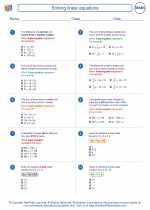Solving linear equations -> sides
Sides in Geometry
In geometry, the term "sides" refers to the straight lines that form the boundaries of a two-dimensional shape or the edges of a three-dimensional object. The number of sides a shape has depends on its type. Here are some common shapes and their respective number of sides:
- Triangle: 3 sides
- Quadrilateral: 4 sides
- Pentagon: 5 sides
- Hexagon: 6 sides
- Heptagon (or Septagon): 7 sides
- Octagon: 8 sides
- Nonagon: 9 sides
- Decagon: 10 sides
Properties of Sides
Each side of a polygon has certain properties that are important to understand:
- Length: The distance between the endpoints of a side.
- Orientation: The direction in which the side is traced, usually either clockwise or counterclockwise.
- Position: The relative location of the side with respect to other sides of the shape.
- Relationships: The angles and lengths formed by different sides in a polygon, which can have various mathematical relationships.
Study Guide: Understanding Sides in Geometry
When studying sides in geometry, it's important to focus on the following key concepts:
- Identifying the number of sides in different polygons and being able to recognize and name these polygons.
- Understanding the properties of sides, including length, orientation, and position in a shape.
- Exploring the relationships between sides and angles within polygons, such as the sum of interior angles in a polygon.
- Applying the concept of sides to solve problems involving perimeter, area, and other geometric measurements.
By mastering these concepts, you'll develop a strong foundation in geometry and be able to confidently work with sides in various shapes and figures.
Good luck with your studies!
[Sides] Related Worksheets and Study Guides:
.◂Math Worksheets and Study Guides Eighth Grade. Solving linear equations
Study Guide Solving linear equations
Solving linear equations  Worksheet/Answer key
Worksheet/Answer key Solving linear equations
Solving linear equations  Worksheet/Answer key
Worksheet/Answer key Solving linear equations
Solving linear equations  Worksheet/Answer key
Worksheet/Answer key Solving linear equations
Solving linear equations  Worksheet/Answer key
Worksheet/Answer key Solving linear equations
Solving linear equations  Worksheet/Answer key
Worksheet/Answer key Solving linear equations
Solving linear equations 

 Worksheet/Answer key
Worksheet/Answer key
 Worksheet/Answer key
Worksheet/Answer key
 Worksheet/Answer key
Worksheet/Answer key
 Worksheet/Answer key
Worksheet/Answer key
 Worksheet/Answer key
Worksheet/Answer key

The resources above cover the following skills:
Algebra (NCTM)
Represent and analyze mathematical situations and structures using algebraic symbols.
Use symbolic algebra to represent situations and to solve problems, especially those that involve linear relationships.